
If you brew Kombucha you might be wondering “What the hell am I supposed to do with all these Scoby’s?” (I’m sure everyone is thinking ‘Scoby Gummy?’) I mean, each batch makes a new scoby and after 4 or 5 of the gelatinous masses you may be wondering what you can do with them. Because let’s face it, if you are making Kombucha you might be a little into not throwing everything away. In comes a use for the Kombucha Scoby! You can eat them. Even better, you can make kombucha scoby gummy candy.
I’ll let you digest that for a moment. (get it?)
If you want to skip down below I’ll walk you through how to make a sweet cinnamon, ginger scoby gummy. But if you are along for this insane ride, then read on:
I had too many scoby (scobies? scoobies?) cluttering up my Kombucha jar already when, Adam, came home from work one day and said: “I ate a kombucha gummy at work today”. For those of you that know, Adam, I swear this is true. Like on my grave, this actually happened! The exchange went like this:
Me: You ate what?
Adam: A kombucha gummy one of my employees made.
Me: I’m sorry, I don’t think I heard you correctly. What was it made out of?
Adam: You heard me, I ate a gummy made out of that gross thing that grows on your kombucha
Me: *blinking a few times as I try to reconcile the man I know, who wouldn’t take an acidophilus pill after the stomach flu, but suddenly ate a random kombucha scoby gummy at work*
Adam: It was pretty good. He says he just dips them in honey and to cut them with scissors cause they are hard to cut.
The Adam went on about his business and I started googling things like “Kombucha Gummy”, “Can I eat a Scoby”, and “Are Scoby edible”. At that point lunch break was over and I gave Adam firm instructions to figure out how they were made. He did ask but came back with vague instructions like “Dry them” and “Dip in sweetener”. Sooooo not like a recipe and then I promptly forgot my plans to make kombucha scoby candy.
Until now! Hence:
How to Make Kombucha Scoby Gummies aka Scoby Candy
Step 1: Regret Your Decision to Make Kombucha Gummies
No, seriously. Have you really spent any time with your scoby? I desperately want to be an earthy hippy, but damn, scoby are nasty. I always try to transfer my scoby over with the least amount of thought and attention, lest I forever am unable to drink kombucha.
Learning how to make a kombucha scoby gummy is going to get you up and personal with your kombucha slime plug. And folks, it ain’t pretty. You have been warned.
- Get a bunch of Kombucha Scoby
- Cut them into 1 inch chunks
There are so many cringe factors during this process I began to question my life choices. I finally equated it to cutting raw chicken fat in my brain. FYI, That didn’t help.
Use a sharp knife, use scissors, pull it apart. I don’t care how you do it. But get them into smaller pieces.
Step 2: If You Actually Want to Go on After Step 1: Marinade
So now that you have this chunked pile of rubbery scoby you will need to sweeten it. (Am I being too real about the process? Let me know in the comments!) Scoby supposedly doesn’t taste like hardly anything by itself. It would take a large sum of money for me to verify this myself. If you want to send me the money I’ll see about tasting a plain kombucha scoby, but otherwise I was content to let the internet be my guide.
I treated my scoby gummies like any other pickling or sugaring process. I layered the scoby gummies in a dish and then covered them with a layer of sugar, cinnamon, and chopped ginger root. Don’t be picky here folks. I found some shriveled ginger on the counter and threw in sugar and cinnamon till it looked “okay”. Then I did layer after layer until it was all covered.
TLDR:
- Cinnamon Powder
- Chunks o’ ginger root
- Sugar
- Scoby
Layer all ingredients and marinate overnight. Stir occasionally.
Step 3: Oh hell, you are really going to see Kombucha Gummies through
Now that you have your bowl of awesome kombucha scoby gummy goodness marinated, its time to get it in gummy form. This part requires cooking or drying. I opted for marinating and drying, because if I have gone this far I am going to go hole hog and try to preserve the most probiotic qualities of the Kombucha Scoby. HOWEVER, if you too, severely questioned your life choices in step 1 but don’t want to throw away the bowl of scoby gummy goodness you made in step 2? Then you can use this cooked Scoby Candy tutorial I found. Otherwise, if you want to go balls out on this whole process continue on. I’m a lady balls out kind of girl:
- Prep a cookie sheet or dehydrator rack with parchment paper.
The Scoby is wet… Like really wet. So I left air circulation slits on both sides and just lined the trays down the middle. If you are using an oven go with 110 degrees for 48 hours. But dehydrate these puppies until they are firm and rubbery, but not brittle.
Why? Because you have a gelatinous mass covered in sticky sugar… You are going to need to get that puppy of the rack somehow. I have this AMAZEBALLS dehydrator I found at a yard sale. If you ever liked late 80’s early 90’s infomercials then you too will covet my original Ronco Food Dehydrator. Covet away.
Step 4: Make Scoby Gummy Candies Visually Appear Like Something You Would Eat
Well, we have come this far on our Kombucha Scoby Gummy adventure. And while they look more like some type of holisitic, natural gummy (read: Dried Fruit) when dried I still think they need fancying up. Aka, made to look like a candy.
Again this is pretty simplistic:
- Powdered Sugar
- Cinnamon Powder
I mixed some together then dusted the pieces for a bit of sweetness and to keep them from sticking together.
Step 5: Taste one. I dare you.
Welp, the big event: Tasting one of these ‘things’ you made. Because we aren’t wusses up in here, and we made this shit, so we will taste it. (Say this with me)
SURPRISE these are actually edible and good!
Also a surprise, a few of my treats got some real ginger fire! I’ll likely use ginger powder next time to even the distribution.
I’m treating mine like other dehydrated foods and assuming they have a limited shelf life (couple O’ months at best in non-hot, non-humid environments). I doubt they will make it that long, but if they do, I plan to wrap them individually in some wax paper twists and freeze or refrigerate.
10/10 would make kombucha scoby gummies while questioning my life choices. Glad I finally found a use for all these scoby!
Please let me know if you try this and any other uses you have for those extra Scoby!




































